AN INSTANT FENCE
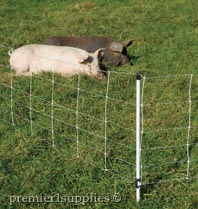
Premier's Pig QuikFence™ can be set up in virtually any hog paddock with ease.
Pig QuikFence™ 6/30/12
| • |
6 horizontal strands |
| • |
30" tall |
| • |
Vertical struts every 12" |
| • |
Post spikes (SS) .31" diameter, 8" long |
As with all electrified netting, it installs quickly and easily, is visible to animals and must be electrified.
Bottom strand is suspended 6" above the ground to prevent pigs rooting soil onto the fence and shorting it out. Users can slide the lower strand higher up if they wish.
For extra support at curves, corners and ends we suggest our FiberTuff™ posts.
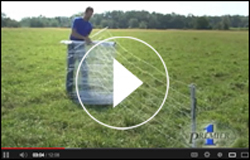
Need to know the best way to set up netting? Watch Premier's video on installing electrified netting.
PREMIER SOLAR ENERGIZERS
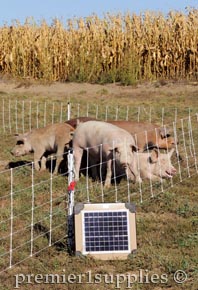
Pastured pigs enjoying their time on pasture safely secure behind Premier's
Pig QuikFence™.
Which unit is right for you?
The size needed, in pulse energy output (range from .5 joule to 2 joules), depends almost entirely on the length of the fence and the weed contact that will occur along the fence line.
Contact Premier or call 800-282-6631 to speak with one of our fence consultants to help you determine the best energizer for your needs.
You can also view our energizer comparison charts online or in Premier's fencing catalog for help in choosing an energizer.
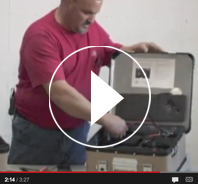
If it's the end of your fencing season, you'll find our video above on how to properly store your energizer and batteries for winter helpful, with instructions and tips the folks at Premier have learned by experience.
|
 |
 |
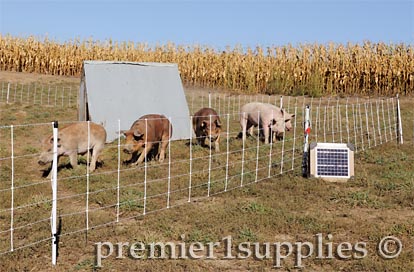
Swine being raised on pasture at the Snakenberg Farm in Sigourney, IA. The Snakenbergs raise pigs for the Niman Ranch program. The pigs in the photo were moved to a new paddock several days later. Pigs are contained with Pig QuikFence and a PRS Energizer.
Pasture Pigs 101
You can raise pasture pigs. All that's needed are pigs and a pasture. Actually, it's a little more complicated than that. You'll also need shelter, fences, feeding and watering systems, but folks all over the United States are doing it. If you're interested in raising pasture pigs, below is a handy fact sheet from Cornell University and the Small Farms program on raising pastured pigs.
Premier visited the Snakenberg Farm in Sigourney, IA. The Snakenberg family has a paddock full of pork, raising 200 swine on pasture for the Niman Ranch program. Per Niman Ranch specifications, the hogs are raised without the aid of antibiotics or hormones and are fed a vegetarian diet. Hogs are marketed under the Niman Ranch label.
Rather than setting up permanent paddocks and fences, the Snakenberg's rotate cropland and pasture land. This year's pasture will be next year's crop ground, and the pigs will move to a new pasture. This allows the cropland to rest for a year or two while being rejuvenated with pig manure.
EXTENSION NEWS
Raising Pastured Pigs
By Cornell University Cooperative Extension
Cornell Small Farms Program & Department of Animal Science
Livestock Fact Sheets
Revised 10/7/05
Introduction
More consumers are requesting that their meat products come from farms that raise their livestock with specific attention paid to housing and management style.
Pasture based swine systems use pasture in the summer and loose hoop housing in the winter. Sows are fed in small groups and generally given a choice of huts to use during farrowing, whether it is inside the hoop house during winter or on pasture during the summer.
General terminology used:
Barrow — Male pig castrated before sexual maturity.
Boar — Intact (not castrated) male pig.
Gilt — Female pig of any age prior to second pregnancy.
Pig — Young swine of either sex.
Piglet — Baby pig.
Sow — Female swine having produced one or more litters.
Farrow — To give birth to a litter of piglets.
Breeds
The breeds that do the best in pasture based systems are not the refined white market hogs found in commercial systems. Preference should be made to purchase breeding stock from hogs that have been raised on pasture systems or have been selected to have a higher tolerance for stress and adaptability to range conditions. Pasture-raised hogs face different stresses and require different traits, such as hardiness in extreme climates, parasite resistance, foraging ability, and good mothering attributes.
Some traditional and heritage swine breeds still retain these characteristics. These breeds include the Berkshire, Chester White, Duroc, Hampshire, Spotted, Tamworth, Poland China, Large Black, Hereford, and Gloucester Old Spot Pig.
Feed Requirements
Good pasture, young and lush, can supply many nutrients to grazing sows. Bred sows and gilts on legume pastures require much less supplemental protein and only one-half as much concentrate as those in dry lots. An acre of good pasture should carry 8 to 10 sows. As a general guideline sows should receive 2 pounds of concentrate a day on good pasture with gilts receiving 3 pounds per day during pregnancy. During lactation, 2 to 3 pounds of 15 percent protein concentrate per 100 pounds body weight is recommended.
Once piglets are weaned, at approx 6 weeks of age, they can be raised in a separate pasture area. Many producers may also start with weaned pigs for their farm enterprise. Growing-finishing hogs in most cases should be full-fed (given concentrate feeds) while on pasture keeping stocking rates around 20 pigs per acre.
Facilities
Electric fencing works well for swine. Remember that you will need to train the pigs to the fence before letting them out in a large area. Electrified netting can also be used, especially with small pigs. Gathering areas or catch pens should be constructed with four foot wire mesh panels.
Huts can be homemade from local lumber sources. Huts spread out on pasture provide sows with a place to farrow (give birth) and use as shelter during inclement weather. Making sure of adequate room for sow and piglets is necessary to prevent accidental crushing of newborns by the sow.
Tom Frantzen, a pasture pork producer in Iowa, advises that 75 square feet may be the best farrowing hut size to allow adequate size for the sow and piglets. Huts that are smaller than this may cause more piglet mortality due to crushing when the sow lies down. Huts can be bedded with straw or poor quality grass hay.
Read More »
|
|